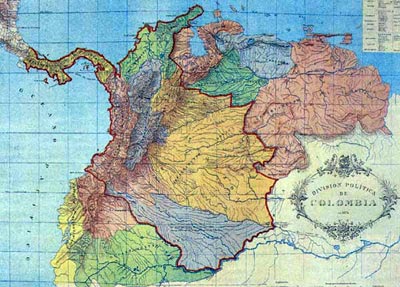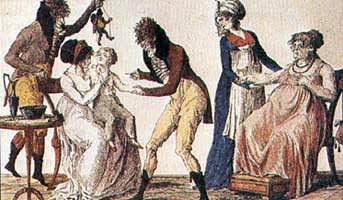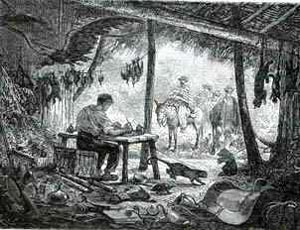|

Gran Colombia in 1824
(Codazzi, A., Atlas geográfico e
histórico de la República de Colombia, Paris, 1889) |
The role of foreign doctors in administering to the troops of
independence in Gran Colombia has been recognised by scholars
since the 1960s. Before then, the study of medical practitioners
had taken a subsidiary position to the historia patria
which focused primarily on battles and their heroes. Most
historians agree, however, that many more soldiers died of
disease in these wars than they did in battle.
(3) The ground-breaking work of José
Rafael Fortique and Francisco Alejandro Vargas in particular,
identified the principal doctors who sought to limit these
losses, drawing primarily on published sources, and postulated
that these men played a key role in ‘modernising’ Simón
Bolívar’s armies and enabling them to resist Spanish forces.
(4) A conference and publication in
1972 brought many contributors to the new field together,
providing much useful biographical detail about the doctors
(foreign and local) who tended to the wars’ wounded. One of the
participants, Franz Conde Jahn, suggested that one of the
principal achievements of the foreign doctors was to revitalise
the image of the medical practitioner, in Venezuela at least,
where prior to independence most doctors were people of colour.
The activity and prestige of white doctors who knew Latin terms,
he argued, gave confidence and strength to the soldiers in the
ranks, and contributed substantially to the victories of
Bolívar’s forces at Boyacá and Carabobo (Dias 1972).
It is worth noting that while the medical practitioners referred
to in the literature above, and in this essay in general, were
all male, recent scholarship has emphasised the role of women in
caring for the sick and wounded during the wars of independence.
The contribution of these women continues to be underestimated
in the literature, due to a perceived lack of sources or a
continued lack of respect for their role. However, a fuller
picture of the role women played in maintaining minimum levels
of hygiene and tending to injuries can be constructed from
references in archival documentation.
(5) The work of the AHRC ‘Gendering Latin American
Independence’ project has unearthed many new sources and
individuals who can be studied from this angle (Brewster 2005).
The study of health care provision in Colombia and Venezuela has
regained the attention of scholars in recent years. Hugo Armando
Sotomayor Tribin’s excellent Guerras, enfermedades y médicos
en
Colombia
builds on the earlier literature whilst placing its attention on
a social history of the period, rather than on its protagonists.
(6) From Sotomayor Tribin’s
extensive archival research we learn, for example, of the
shopping lists of doctors in 1819 - including powdered rhubarb
and selected peanuts, with their respective prices
(Sotomayor Tribin 1997: 201). He reveals
that Irish doctors such as Thomas Foley used alcohol as an
anaesthetic when performing amputations after key independence
battles such as Boyacá and Pantano de Vargas (Sotomayor Tribin
1997: 190). Sotomayor Tribin makes a strong case for seeing ill
health as one of the principal protagonists of the wars of
independence, and its treatment one of the neglected social
concerns of the period. For him dysentery, poor nutrition and
yellow fever determined the course of military campaigning and
shaped the societies that were born out of warfare. 1830 is
often taken to mark an epoch in Colombian history; for Sotomayor
Tribin this is because ‘yellow fever appears in the country’s
interior, […] Gran Colombia is dissolved, and Bolívar dies’ (Sotomayor
Tribin 1997: 213).
My own work on foreign participation in the wars of independence
in Gran Colombia has emphasised the Irish predominance in
expeditions also comprising English, Scottish, German, Italian,
French, Spanish, Maltese and Welsh men and women (Brown 2006).
In 2007 I posted online a database which contains preliminary
biographical details for over 3,000 of the 7,000 foreigners who
joined the cause of independence, drawn from my own larger
database. The database can be consulted freely (http://www.bristol.ac.uk/hispanic/latin/research.html).
Searching the database for ‘Irish’ and ‘Surgeon’ or ‘Doctor’ as
rank, or ’Apothecary’ as profession, brings up a total of 85
names. (7) Some of these are well
known already, such as the aforementioned Thomas Foley and James
H. Robinson (also known as Robertson), and accounts of their
careers can be found in the general accounts of Alfred Hasbrouck
or Eric Lambert. The database shows that in the years after
independence Irish doctors who had made their reputations during
the wars were scattered across Gran Colombia: William Porter
Smyth settled, married and practiced in
Cartagena
de Indias. John Irwin of County Sligo settled, married and
practiced in Maracaibo, leaving a line of descendents begun by
his daughter Margarita, who claimed his pension upon her
father’s death in 1846 (AGN). Richard Murphy settled in
Puerto Cabello
(Lambert 1984: 35). Trinity College in Dublin provided many of
the Irish doctors who served in
Venezuela,
Colombia or Ecuador. Edward French Mullery and William Murphy,
both of
Sligo, were
amongst those who sailed for Colombia after graduation. The
traveller William Duane recalled meeting them at their practice
in Barquisameto in the early 1820s: Duane commented that ‘they
were held in the highest estimation, as well as for their
professional merits, as the exemplary integrity of their social
character’ (Duane 1826: 185).
Many of the Irish doctors who appear in the database are not
mentioned in the studies cited above. Periphery characters such
as Henry Smith, who when questioned entered his profession as an
‘apothecary’ in Achaguas, Venezuela, in December 1820, have only
been identified by means of careful accumulation of archival
material (AHG). Others slipped through the official records
because of the improvised nature of their recruitment, such as
Dr Beaurain, who was serving with the British Navy and who,
according to the account published in Jamaica at the time, was
‘forced to accept the situation of Director-General of Hospitals
of Venezuela’, where he served in Angostura (Royal Gazette,
25 September 1819; Carrick’s Morning Post, 24 January
1820). Many of the doctors shared the same fate as the men they
hoped to heal: death from the many diseases that afflicted them,
especially in coastal regions. This was the case of Dr John
Mortimer, who died while marching from Juan Griego to Porlamar
on the
island of
Margarita
in 1819 (Dublin Evening Post, 30 November 1820). A
similar fate befell Dr Alexander Costello, a graduate of
Apothecary’s Hall in Dublin, who died of yellow fever in 1822,
having served three years as Inspector General de Hospitales
for the troops under the command of General John Devereux
(Devereux to O'Connell, 16 July 1822).
Some foreign doctors arrived after independence had been
secured, such as Davoren, Dudley, Jervis and the most famous of
them all, the Scotsman Ninian Cheyne (Sotomayor Tribin 1997:
205). Cheyne settled in Bogotá after independence and became a
crucial nexus between Colombian and British interests in the
capital. It is possible that he was also trained at Trinity
College in Dublin. (8)
|

Vaccination in the early nineteenth century
(National Library, Paris) |
W. Davidson Weatherhead may have been another Trinity College
graduate who served in the wars of independence. He wrote two
books after his return to Europe, one of which described the
tribulations of General Gregor MacGregor’s attacks on the coast
of Panama. Its final pages demonstrate an interest in local
ailments and diseases, with particular reference to fever,
sexual organs, consumption, colic and ulcers. Weatherhead’s
conclusions, that the Spanish forces lost more men to disease
than the British and Irish who served with the Independents, is
in line with Rebecca Earle’s recent synthesis of the role of
disease in the wars of independence (Earle 1996). Unlike Earle,
whose analysis does not address this differential, Weatherhead
asserted that the Irish and British survived more often because
Spanish practitioners ‘know nothing of medical science’ (Weatherhead
1821: 134).
One Irish doctor in
Colombia
who has been studied in some depth is Hugo Blair Brown. His
biographer, and descendent by marriage, Aquiles Echeverri,
provides useful detail on Blair’s personal and professional
life. The author is keen to contrast his noble, disinterested
medical services with the Irish soldiers who travelled to
Colombia at the same time, who he sees as craven, mercenary and
unpatriotic. Comandante Rupert Hand, the Irish mercenary who
killed General José María Córdova in 1829 after the battle of El
Santuario, epitomises for Echeverri the worst excesses of
unwanted Irish intervention in Colombian affairs. In contrast,
he sees Blair and other doctors like him as a benign force for
good. (9)
Protestant in origin, Hugo Blair converted to Catholicism in
Medellín in 1829, and married into the important local Gaviria
family in 1836. He worked in Medellín until his death in 1864,
and Echeverri posits Blair as a patriotic Colombian who founded
an impressive line of descendents who should be proud of their
‘Irish blood’. Echeverri’s dedication to the subject went so far
as to have Blair’s remains exhumed from the San Pedro Cemetery
in Medellín, where they had lain since Blair’s death, in order
to measure his bones and provide an accurate identification of
his resting place (Echeverri 1972: 36). The book contains
interesting oral history testimony from the subject’s
grand-daughter, Julia Blair Gaviria, transcribed in the 1960s.
Apparently in 1857 the Antioquian caudillo Mariano Ospina
Rodriguez had asked Blair to assist him in a medical capacity,
but Blair replied ‘Yo no presto servicios a quienes fueron
traidores
del General Bolívar’ (Echeverri 1972: 52). (10)
In conclusion it can be asserted that the Irish doctors who
served in the wars of independence in Gran Colombia provided an
important service to the army and navy. Their contribution was
acknowledged by contemporaries who sought them out for service
and for treatment. Those who settled in the Gran Colombian
republics even after Bolívar’s death in 1830, found a settled
lifestyle and a degree of social status that would have been
difficult to attain in
Britain
or Ireland. It was the social status attained by these
peace-time practitioners that secured the reputation of their
colleagues who had served in wartime. Historians in both
Colombia and Venezuela have recorded the names of most
prestigious of these doctors. It is to be hoped that this essay
has provided an outline of a research topic that remains
relatively un-mined and which can provide an important
contribution to the social and cultural history of the new
republics.
Matthew Brown
Notes
1 Dr Matthew Brown is Lecturer
in Latin American Studies at University of Bristol.
2 Gran Colombia is the term used
by most historians to refer to the republic formed by Simón
Bolívar in 1819, and which was dissolved in 1830. Its
territory covered the present-day republics of Ecuador,
Colombia, Panama and Venezuela.
3
For a review of the literature see: Earle 1996: 371-83.
4
Fortique's more accessible work is
Crónicas médicas de la independencia venezolana.
5
See Davies 2006 and Brown 2005.
6
See
also the less accomplished Silva Alvarez 1985.
7
This
figure includes individuals whose origin is unknown and as
such is entered on the database as ‘British or Irish’. My
findings in Adventuring through Spanish Colonies
suggest that such a person was more likely than not to be
from Ireland.
8
John
Watson Stewart lists a Dr Cheyne as a non-practising member
of the College of
Physicians in Dublin (Watson Stewart 1820:
1170). One of Cheyne’s descendents produced a short
biographical paper on his ancestor, which I have been unable
to locate.
Jaime C. Gomez, ‘Doctor Ninian Cheyne: Profesor Escocés de
la Cirugia en Colombia’, paper presented to the Academia
Nacional de la medicina, 26 May 1982 (Abel 1994).
9
In
2007 I travelled to El Santuario with the support of a
research grant from SILAS, which I gratefully acknowledge.
My book on the battle of El Santuario and its consequences
will be published in 2010.
10
My
translation: ‘I will not serve those who betrayed General
Bolívar’.
References
- Abel,
Christopher. Health Care in
Colombia 1920-1950
(London: Institute of Latin American Studies, 1994).
-
Aquiles Echeverri, Sangre irlandesa en Antioquia: Biografía
del doctor Hugo Blair Brown, miembro de la Legión Británica, y
médico coronel de los ejércitos patriotas (Medellín:
Academia Antioqueña de Historia, 1972).
-
Archivo General de la Nación (Caracas, Venezuela).
Ilustres Próceres, Vol. 43. Cited as
AGN.
- Archivo
Histórico de Guayaquil, Papers of the British Legion at
Achaguas,
22 December 1820,
Acta
1. Cited as AHG.
- Brewster,
Claire. Gendering Latin American
Independence:
Women's Political Culture and the Textual Construction of Gender
1790-1850 (Nottingham: Department of Hispanic and Latin American Studies,
University of
Nottingham, 2005), online database (http://www.genderlatam.org.uk/database.php),
accessed 9 November 2008.
- Brown,
Matthew. ‘Adventurers, Foreign Women and Masculinity in the
Colombian Wars of
Independence’, Feminist Review, 79 (January 2005), pp.
36-51.
- Brown,
Matthew. Adventuring through Spanish Colonies: Simón Bolívar,
Foreign Mercenaries and the Birth of New Nations (Liverpool:
Liverpool University Press, 2006).
- Carrick’s
Morning Post, 24 January 1820.
- Davies,
Catherine, Claire Brewster and Hilary Owen, South American
Independence: Gender, Politics, Text (Liverpool:
Liverpool
University Press, 2006)
- Días, Fabián
de Jesús, Eric Lambert et al. Los médicos en la
batalla de Carabobo (Caracas: Academia Nacional de Medicina,
Ministerio de Educación, 1972).
- Duane,
William. A visit to
Colombia in 1822 & 1823, by Laguayra and
Caracas, over
the Cordillera to Bogota, and thence by the
Magdalena to Cartagena
(Philadelphia: Thomas H. Palmer, 1826).
-
Dublin Evening
Post,
30 November 1820
- Earle,
Rebecca, ‘A Grave for Europeans? Disease, Death and the Spanish
American Revolutions’ in War in History, 3 (1996), pp.
371-383.
- Fortique,
José Rafael. Crónicas médicas de la independencia venezolana
(Caracas: Academia Nacional de la Historia, 1989).
-
Fortique, José Rafael. Médicos y medicina de nuestra
independencia (Maracaibo: Universidad de Zulia, 1967)
- Hasbrouck,
Alfred. Foreign Legionaries in the Liberation of Spanish
South
America
(New York: Columbia University Press, 1928)
- John Devereux
to Morgan O'Connell, 16 July 1822 (Bogotá, manuscript in
National Library of Ireland, Microfilm, n. 2718 p. 1622).
- Lambert, Eric
T.D. 'Irish Soldiers in South America 1818-1830 (Illustrated)',
The Irish Sword, 16:62 (1984), pp. 22-36.
- Lambert,
Eric. Voluntarios británicos e irlandeses en la gesta
bolivariana (Caracas: Ministerio de Defensa, 1983, 1990), 3
Vols.
- Royal
Gazette (Jamaica), 25 September 1819.
- Silva Álvarez,
Alberto. Situación medico-sanitaria de
Venezuela durante la época del Libertador (Caracas: Biblioteca de la Academia Nacional de la Historia,
1985).
- Sotomayor
Tribin, Hugo Armando. Guerras, enfermedades y médicos en
Colombia
(Bogotá: Escuela de Medicina Juan N. Corpas, 1997).
- Vargas,
Francisco Alejandro. Médicos, cirujanos y practicantes
próceres de la nacionalidad (Caracas, 1964).
- Watson
Stewart, John. The Gentleman's and Citizen's Almanack,
compiled by John Watson Stewart, for the year of our Lord 1820,
&c (Dublin: John Watson Stewart, 1820)
- Weatherhead,
W. Davidson. A Medical and Philosophical Essay, on the
Influence of Custom and Habit on the Human Economy (London:
G & T Underwood, 1828).
-
Weatherhead, W. Davidson. An account of the late expedition
against the Isthmus of Darien under the command of Sir Gregor
McGregor; together with the events subsequent to the recapture
of Porto Bello, till the release of the prisoners from Panama;
remarks on the present state of the patriot cause and on the
climate and diseases of South America (London: Longman,
Hurst, Rees, Orme & Brown, 1821), p. 134. |



